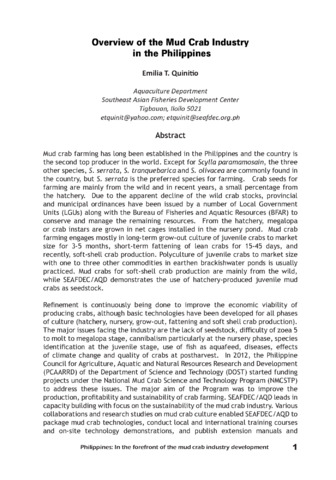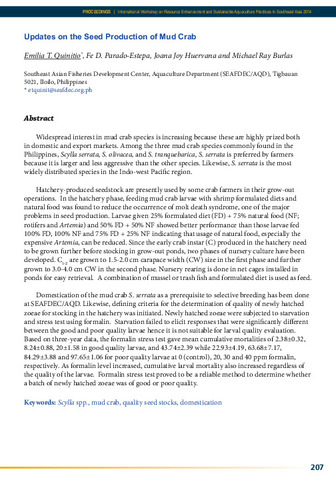Seed production of mud crab Scylla serrata juveniles
- Global styles
- MLA
- Vancouver
- Elsevier - Harvard
- APA
- Help

ดู/
วันที่
2001ผู้เขียน
Page views
3,004ASFA keyword
AGROVOC keyword
Taxonomic term
เมตาดาต้า
แสดงระเบียนรายการเต็ม
Share
นามธรรม
A protocol for the large-scale rearing of the mud crab Scylla serrata juveniles was developed based on the results of small-scale experiments on feeding and water management. This paper also reports the success in producing the second generation (F2) crabs.
Pond-reared adult S. serrata held in 10 m3 concrete tanks with sand substrates were given fish, mussel, annelids and formulated diet. The zoeae produced were stocked in 1.5 or 10 m3 tanks at 30 to 50 ind-l-1 and fed 10 to 15 Brachionus rotundiformis ml-1, 1 to 5 Artemia sauna nauplii ml-1 and 1.5 to 2.0 g shrimp larval commercial diet-m-3 day. Water was replaced daily at 30 to 50% of the total volume starting day 3. Megalops were nursed until crab stage either in tanks or in net cages installed in ponds. Crabs were fed mussel or small shrimps (Acetes sp).
Hatching occurred 6 to 12 days after spawning at 26.5 to 30.5°C. A female produced 0.42 to 5.23 x 106 zoeae at a time. Mean survival rate from zoea 1 to 3- to 5-day old megalopa was 2.6 ± 0.8% and 32.8 ± 4.8% from megalopa to crab stage. The development from zoea 1 to megalopa required 16 to 18 days. Cannibalism and luminescent bacteria were identified as the major causes of mortality. Highest mortality was observed during the metamorphosis from zoea 5 to megalopa and megalopa to crab 1. First crab stage was obtained 23 to 25 days after hatching. Sorting the crabs during the nursery period minimized cannibalism.
Completion of the cycle in captivity was attained in 1997 and 1999 when spawns from pond-reared crabs grew to become the second-generation broodstock. The results point to a minimum age of 7.5 to 9 months at which S. serrata hatched their eggs after rearing from zoea 1.
การอ้างอิง
Quinitio, E. T., Parado-Estepa, F. D., Millamena, O. M., Rodriguez, E., & Borlongan, E. (2001). Seed production of mud crab Scylla serrata juveniles. Asian Fisheries Science , 14(2), 161-174. http://hdl.handle.net/10862/1910
Type
ArticleISSN
0116-6514คอลเลกชัน
- Journal Articles [1258]
Related items
Showing items related by title, author, creator and subject.
-
Overview of the mud crab industry in the Philippines
Mud crab farming has long been established in the Philippines and the country is the second top producer in the world. Except for Scylla paramamosain, the three other species, S. serrata, S. tranquebarica and S. olivacea ... -
Updates on the seed production of mud crab
Quinitio, Emilia T. ; Parado-Estepa, Fe D.; Huervana, Joana Joy; Burlas, Michael Ray (Aquaculture Department, Southeast Asian Fisheries Development Center, 2015)
Widespread interest in mud crab species is increasing because these are highly prized both in domestic and export markets. Among the three mud crab species commonly found in the Philippines, Scylla serrata, S. olivacea, ...
; Parado-Estepa, Fe D.; Huervana, Joana Joy; Burlas, Michael Ray (Aquaculture Department, Southeast Asian Fisheries Development Center, 2015)
Widespread interest in mud crab species is increasing because these are highly prized both in domestic and export markets. Among the three mud crab species commonly found in the Philippines, Scylla serrata, S. olivacea, ... -
Development of protocol for the production of hatchery-reared mud crab Scylla serrata juveniles for soft-shell crab farming
Quinitio, Emilia T. ; Libunao, Gardel Xyza; Parado-Estepa, Fe D. (Aquaculture Department, Southeast Asian Fisheries Development Center, 2017)
Development of economically viable techniques for growing hatchery-reared juvenile crabs to suitable sizes will address the problem on the source of seed stocks for soft-shell crab farming. This paper reports the production ...
; Libunao, Gardel Xyza; Parado-Estepa, Fe D. (Aquaculture Department, Southeast Asian Fisheries Development Center, 2017)
Development of economically viable techniques for growing hatchery-reared juvenile crabs to suitable sizes will address the problem on the source of seed stocks for soft-shell crab farming. This paper reports the production ...





